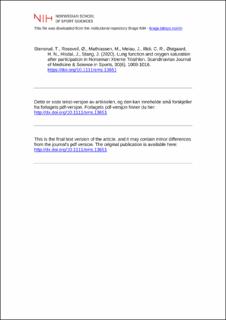| dc.contributor.author | Stensrud, Trine | |
| dc.contributor.author | Rossvoll, Øyvind | |
| dc.contributor.author | Mathiassen, Maria | |
| dc.contributor.author | Melau, Jørgen | |
| dc.contributor.author | Illidi, Camilla Rønn | |
| dc.contributor.author | Østgaard, Hege Nymo | |
| dc.contributor.author | Hisdal, Jonny | |
| dc.contributor.author | Stang, Julie | |
| dc.date.accessioned | 2021-03-12T10:43:58Z | |
| dc.date.available | 2021-03-12T10:43:58Z | |
| dc.date.created | 2020-03-19T10:03:24Z | |
| dc.date.issued | 2020 | |
| dc.identifier.citation | Scandinavian Journal of Medicine & Science in Sports. 2020, 30(6), 1008-1016. | en_US |
| dc.identifier.issn | 0905-7188 | |
| dc.identifier.uri | https://hdl.handle.net/11250/2733116 | |
| dc.description | I Brage finner du siste tekst-versjon av artikkelen, og den kan inneholde ubetydelige forskjeller fra forlagets pdf-versjon. Forlagets pdf-versjon finner du på onlinelibrary.wiley.com / In Brage you'll find the final text version of the article, and it may contain insignificant differences from the journal's pdf version. The definitive version is available at onlinelibrary.wiley.com | en_US |
| dc.description.abstract | Objectives: To examine evidence of exercise-induced bronchoconstriction (EIB) defined as ≥10% reduction in forced expiratory volume in one second (FEV1 ) and exercise-induced arterial hypoxemia (EIAH) defined as ≥4% reduction in oxygen saturation (SpO2 ) from before to after participation in the Norseman Xtreme Triathlon. Secondarily, to assess whether changes in FEV1 and SpO2 are related to respiratory symptoms, training volume, and race time. Methods: In this quasi-experimental non-controlled study, we included 63 triathletes (50♂/13♀) aged 40.3 (±9.0) years (mean ± SD). Fifty-seven (46♂/11♀) measured lung function and 54 (44♂/10♀) measured SpO2 before the race, 8-10 minutes after the race (post-test 1) and the day after the race (post-test 2). Respiratory symptoms and training volume were recorded with modified AQUA questionnaire. ANOVA for repeated measures was used to detect differences in lung function and SpO2 . Statistical significance was accepted at 0.05 level. Results: Twenty-six participants (46%) presented with EIB at post-test 1 and 16 (28%) at post-test 2. Lung function variables were significantly reduced from baseline to post-test 1 and 2. Thirty-five participants (65%) showed evidence of mild to moderate EIAH. No significant correlations were observed except a weak correlation between maximal reduction in FEV1 and respiratory symptoms (r = 0.35, P = .016). Conclusion: Our results demonstrated that 46% of the participants presented with EIB and 65% showed evidence of EIAH after the Norseman Xtreme Triathlon. Changes in FEV1 and SpO2 were not correlated to weekly training hours or race time. We observed a weak correlation between maximal reduction in FEV1 and respiratory symptoms. | en_US |
| dc.language.iso | eng | en_US |
| dc.subject | exercise‐induced arterial hypoxemia | en_US |
| dc.subject | exercise‐induced bronchoconstriction | en_US |
| dc.subject | triathletes | en_US |
| dc.title | Lung function and oxygen saturation after participation in Norseman Xtreme Triathlon | en_US |
| dc.type | Peer reviewed | en_US |
| dc.type | Journal article | en_US |
| dc.description.version | acceptedVersion | en_US |
| dc.source.pagenumber | 1008-1016 | en_US |
| dc.source.volume | 30 | en_US |
| dc.source.journal | Scandinavian Journal of Medicine & Science in Sports | en_US |
| dc.source.issue | 6 | en_US |
| dc.identifier.doi | 10.1111/sms.13651 | |
| dc.identifier.cristin | 1802353 | |
| dc.description.localcode | Institutt for idrettsmedisinske fag / Department of Sports Medicine | en_US |
| cristin.ispublished | true | |
| cristin.fulltext | original | |
| cristin.fulltext | postprint | |
| cristin.qualitycode | 2 | |
